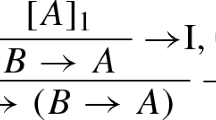Abstract
In this paper we use proof-theoretic methods, specifically sequent calculi, admissibility of cut within them and the resultant subformula property, to examine a range of philosophically-motivated deontic logics. We show that for all of those logics it is a (meta)theorem that the Special Hume Thesis holds, namely that no purely normative conclusion follows non-trivially from purely descriptive premises (nor vice versa). In addition to its interest on its own, this also illustrates one way in which proof theory sheds light on philosophically substantial questions.
Article PDF
Similar content being viewed by others
Avoid common mistakes on your manuscript.
References
Brown, C. (2014). Minding the Is-Ought gap. Journal of Philosophical Logic, 43, 53–69.
Chellas, B. F. (1980). Modal logic: An introduction. Cambridge: Cambridge University Press.
Fine, K. (2017). Truth-maker content I. Journal of Philosophical Logic, 46, 625–674.
Fine, K. (2017). Truth-maker content II. Journal of Philosophical Logic, 46, 675–702.
Fine, K. (2021). Truthmaking and the Is–Ought gap. Synthese, 198(2), 887–914.
Fuhrmann, A. (2017). Deontic modals: Why abandon the default approach. Erkenntnis, 82(6), 1351–1365.
Hakli, R., & Negri, S. (2012). Does the deduction theorem fail for modal logic? Synthese, 187(3), 849–867.
Horty, J. F. (2007). Reasons as defaults. Philosophers’ Imprint, 7(3), 1–28.
Horty, J. F. (2012). Reasons as defaults. New York: Oxford University Press.
Humberstone, L. (2019). Recent thought on is and ought: Connections, confluences and rediscoveries. FLAP, 6(6), 1373–1446.
Hume, D. A. (1978). Treatise on Human Nature, 2nd edn. New York: Oxford University Press.
McNamara, P., & Van De Putte, F. (2021). Deontic logic. In E. N. Zalta (Ed.) The Stanford encyclopedia of philosophy. Spring 2021. Stanford: Metaphysics Research Lab, Stanford University.
Morscher, E. (2012). Normenlogik - Grundlagen, Systeme, Anwendungen. Paderborn: Mentis Verlag.
Negri, S., & von Plato, J. (1998). Cut elimination in the presence of axioms. Bulletin of Symbolic Logic, 4(4), 418–435.
Negri, S., & von Plato, J. (2001). Structural proof theory. Cambridge: Cambridge University Press.
Negri, S., & von Plato, J. (2011). Proof analysis: A contribution to Hilbert’s last problem. Cambridge: Cambridge University Press.
Orlandelli, E. (2014). Proof analysis in deontic logics. In F. Cariani, D. Grossi, J. Meheus, & X. Parent (Eds.) Deontic logic and normative systems, DEON 2014, LNCS, (Vol. 8554 pp. 198–216). Cham: Springer.
Pigden, C. (Ed). (2010). Hume on Is and Ought. London: Palgrave Macmillan.
Poggiolesi, F. (2012). On the importance of being analytic: The paradigmatic case of the logic of proofs. Logique et Analyse, 55(219), 443–461.
Prior, A. (1960). The autonomy of ethics. Australian Journal of Philosophy, 83(3), 199–206.
Restall, G., & Russell, G. (2010). Barriers to implication. In C. Pigden (Ed.) Hume on Is and Ought (pp. 243–260). London: Palgrave Macmillan.
Russell, G. (2022). How to prove Hume’s law. Journal of Philosophical Logic, 51(3), 603–632.
Schurz, G. (1997). The is-ought problem: An investigation in philosophical logic, vol. 1 of Trends in Logic. Dordrecht: Springer.
Schurz, G. (2010). Non-trivial versions of Hume’s Is-Ought thesis. In Hume on Is and Ought (pp. 198–216). London: Palgrave Macmillan.
Singer, D. J. (2015). Mind the Is-Ought gap. Journal of Philosophy, 4, 193–210.
Smullyan, R. M. (1986). Logicians who reason about themselves. In J. Halpern (Ed.) Theoretical aspects of reasoning about knowledge, (pp. 341–352). Los Altos: Morgan Kaufmann.
Smullyan, R. M. (1987). Forever Undecided A Puzzle Guide to Gödel. New York: Alfred A. Knopf Inc.
Troelstra, A., & Schwichtenberg, H. (2000). Basic Proof Theory. In Cambridge tracts in theoretical computer science. 2nd edn. Cambridge: Cambridge University Press.
Williamson, T. (2002). Knowledge and its Limits. Oxford University Press on Demand.
Funding
Open Access funding enabled and organized by Projekt DEAL. Gefördert durch die Deutsche Forschungsgemeinschaft (DFG) - Projektnummer 459928802. Funded by the German Research Foundation (DFG) - Project number 459928802.
Author information
Authors and Affiliations
Contributions
The entirety of this paper represents joint work of both authors, based on first author’s prior idea.
Corresponding author
Ethics declarations
Conflict of Interests
All authors certify that they have no affiliations with or involvement in any organization or entity with any financial interest or non-financial interest in the subject matter or materials discussed in this manuscript.
Additional information
Publisher’s Note
Springer Nature remains neutral with regard to jurisdictional claims in published maps and institutional affiliations.
Special thanks goes to O. Foisch.
Rights and permissions
Open Access This article is licensed under a Creative Commons Attribution 4.0 International License, which permits use, sharing, adaptation, distribution and reproduction in any medium or format, as long as you give appropriate credit to the original author(s) and the source, provide a link to the Creative Commons licence, and indicate if changes were made. The images or other third party material in this article are included in the article's Creative Commons licence, unless indicated otherwise in a credit line to the material. If material is not included in the article's Creative Commons licence and your intended use is not permitted by statutory regulation or exceeds the permitted use, you will need to obtain permission directly from the copyright holder. To view a copy of this licence, visit http://creativecommons.org/licenses/by/4.0/.
About this article
Cite this article
Gratzl, N., Pavlović, E. Is, Ought, and Cut. J Philos Logic 52, 1149–1169 (2023). https://doi.org/10.1007/s10992-023-09701-y
Received:
Accepted:
Published:
Issue Date:
DOI: https://doi.org/10.1007/s10992-023-09701-y




